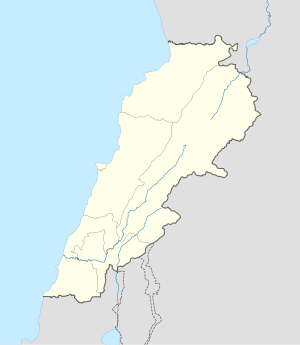- Maghdouché
-
Maghdouché
مغدوشةLocation in Lebanon Coordinates: 33°31′18″N 35°23′09″E / 33.52167°N 35.38583°E Country  Lebanon
LebanonGovernorate South Governorate District Sidon District Time zone EET (UTC+2) – Summer (DST) +3 (UTC) Maghdouché (also Maghdouche, Maghdoucheh or Maghdousheh) is a town in the South Governorate in Lebanon. It is located 50 km south of Beirut and 8 km southeast of Sidon.[1] The village lies 3 km inland from the Mediterranean, occupying a hill with elevation ranging between 200 to 229 meters above sea level.[2]
Contents
Demographics
Maghdouché has a permanent population of 8,000 inhabitants, the majority of whom are Melkite Catholics and few Maronite Catholics. [1] The population of the town doubles when the expatriates return to spend their summer vacations in their ancestral home.
Economy
Maghdouché's main industry is agriculture. The town produces grapes and citrus fruits, especially oranges. The town is famous for its best quality orange-blossom water.[1] On April 2006, USAID funded a $195,000 cooperative of flower blossom and rose water production center, which will serve more than 950 farmers in the Magdhouche area.[3]
History
The name, Maghdouché, originates from the Syriac word, which means "crop collectors." It is also derived from the Syriac word Kidsh and its derivatives (Kadisho, Kadishat, Makdosho). In Hebrew, it means "holy" or "saintly." According to Christian belief, when Jesus came to Sidon, the Virgin Mary who accompanied him, waited for him at the top of the hill where Maghdouché is located today. She spent the night in a cave that came to be known as Mantara, or the "Awaiting." Emperor Constantine the Great responded to St. Hélène's request and transformed the cave into a sanctuary for the Virgin. He erected a tower in honor of the Virgin. The tower collapsed during the earthquake of 550. Later, King Louis IX erected a watching tower in the same location. The Mantara cave was once again discovered accidentally by a shepherd in 1726. An icon of the Virgin was also discovered, and it was of Byzantine style, dating back to the 7th or to the 8th century. Since then, the cave has been transformed into a place of pilgrimage for all the Lebanese confessions. In 1860, the Greek Catholic Church became the owner, and transformed the cave into a sanctuary in 1880.
At the beginning of the sixties, under the auspices of Mgr Basile Khoury, renowned architect Varoujan Zaven designed and executed a beautiful hexagonal chapel topped by a 36-meter tower in a conical shape to support an 8 and a half meter one-piece bronze statue of the Virgin Mary holding Jesus in her arms, of his own design as well, realized by Italian artist Pierrotti in Pietra Santa. The design and supervision of the project were both a donation on behalf of the architect. Our Lady of Mantara is considered the protectress of children, and many baptisms are celebrated at the sanctuary.
On November 22nd 1986, the armed conflict between Amal (Shi'a Muslim militias) and the PLO (The Palestine Liberation Organization) spread to Maghdouché. Ferocious combats took place in this Christian strategic town. Ultimately, it fell partially in the hands of the Palestinians and its residents were forced to flee from their homes. Maghdouché was destroyed. In 1990, after four years, the resident of Maghdouché returned to the ruins of their village and began rebuilding what was destroyed in the war.[4]
Main sights
Maghdouché's most famous landmark is the tower of Our Lady of Mantara, which is a Marian shrine built (May 16, 1963) [5], above the cave that is believed to have been the resting place of the Virgin Mary as she waited for Jesus while he preached in Sidon. The tower height is 28 m, Statue height: 8.5 m, width: 3.5 m and the weight is 6 Tons [6]
Popular culture
A tribute to the town was sung by Lebanese singer Diana Haddad on her 2000 album Jarh AL Habib titled Maghdouche or Mishtaqit Laki Ya Maghdouche ("I miss you Maghdouche"). In September 2009 Haddad performed the same song in honour of the village while participating in their annual music festival held in the town,the singer's ancestral home.[7]
References
- ^ a b c maghdouche.pipop.org
- ^ Discussion: 2. Al-Mountara ?
- ^ Usaid: Lebanon: Welcome To Usaid | Lebanon
- ^ history
- ^ Notre Dame de Mantara. By Bishop Maksimos Constantine 1963
- ^ Notre Dame de Mantara. By Bishop Maksimos Constantine 1963
- ^ http://www.albawaba.com/en/countries/Lebanon/253432
Coordinates: 33°31′18″N 35°23′09″E / 33.52167°N 35.38583°E
Categories:- Sidon District
- Mary (mother of Jesus)
- Populated places in the South Governorate
- History of Lebanon
- Lebanese society
Wikimedia Foundation. 2010.

